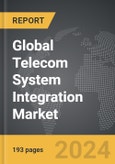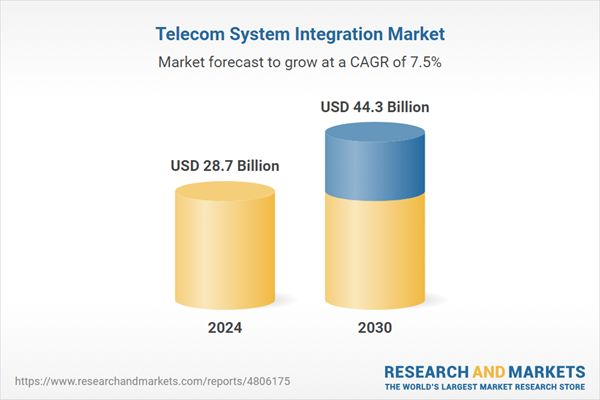Global Telecom System Integration Market - Key Trends and Drivers Summarized
Why Is Telecom System Integration Essential for the Telecom Industry?
Telecom system integration involves the coordination and integration of various telecom components, platforms, and technologies to ensure seamless network operations. As telecom companies adopt new technologies such as 5G, SDN, and NFV, system integration plays a crucial role in aligning these technologies with existing infrastructure. Effective integration reduces operational complexity, improves network performance, and enables telecom operators to deliver advanced services such as cloud-based applications and IoT connectivity. With the growing complexity of telecom networks, system integration ensures that different systems can work together efficiently, enhancing the overall network reliability and customer experience.How Is 5G Driving the Demand for Telecom System Integration?
The deployment of 5G networks is significantly boosting the demand for telecom system integration services. 5G networks are characterized by higher speeds, lower latency, and increased connectivity, all of which require seamless integration between hardware, software, and network components. System integration services enable telecom operators to upgrade their existing infrastructure to support 5G while ensuring backward compatibility with older technologies. Additionally, the integration of cloud computing, edge computing, and AI into telecom networks further drives the need for comprehensive system integration solutions to manage the increased network complexity and ensure optimal performance.What Segments Are Contributing to the Growth of the Telecom System Integration Market?
Service types include network integration, cloud integration, and data center integration. Network integration is particularly critical as telecom operators seek to modernize their networks to support 5G and IoT. Cloud integration is also growing in importance as telecom operators move their services to cloud-based platforms to reduce costs and improve scalability. Geographically, North America dominates the market due to early 5G deployments and the presence of advanced telecom infrastructure, while Asia-Pacific is expected to witness rapid growth as telecom operators in emerging markets expand their networks and adopt new technologies.The Growth in the Telecom System Integration Market Is Driven by Several Factors
The growth in the telecom system integration market is driven by several factors, including the deployment of 5G networks, the increasing adoption of cloud-based services, and the growing complexity of telecom infrastructure. As telecom operators expand their networks and adopt new technologies, the need for efficient system integration solutions is becoming critical. The shift toward SDN and NFV technologies, which enable more flexible and scalable network architectures, is also driving demand for system integration services. Additionally, the rise of IoT devices and edge computing is creating new opportunities for telecom system integration as operators seek to connect and manage diverse network components. The ongoing digital transformation of the telecom industry, combined with the increasing demand for seamless connectivity, will continue to fuel growth in the telecom system integration market.Report Scope
The report analyzes the Telecom System Integration market, presented in terms of units. The analysis covers the key segments and geographic regions outlined below.Segments: Application (OSS, BSS, Network Management, Digital Services); Type (Cloud, On-Premises).
Geographic Regions/Countries: World; United States; Canada; Japan; China; Europe (France; Germany; Italy; United Kingdom; and Rest of Europe); Asia-Pacific; Rest of World.
Key Insights:
- Market Growth: Understand the significant growth trajectory of the Cloud Deployment segment, which is expected to reach US$20.2 Billion by 2030 with a CAGR of a 8.9%. The On-premises segment is also set to grow at 6.4% CAGR over the analysis period.
- Regional Analysis: Gain insights into the U.S. market, valued at $8.0 Billion in 2024, and China, forecasted to grow at an impressive 7.0% CAGR to reach $6.8 Billion by 2030. Discover growth trends in other key regions, including Japan, Canada, Germany, and the Asia-Pacific.
Why You Should Buy This Report:
- Detailed Market Analysis: Access a thorough analysis of the Global Telecom System Integration Market, covering all major geographic regions and market segments.
- Competitive Insights: Get an overview of the competitive landscape, including the market presence of major players across different geographies.
- Future Trends and Drivers: Understand the key trends and drivers shaping the future of the Global Telecom System Integration Market.
- Actionable Insights: Benefit from actionable insights that can help you identify new revenue opportunities and make strategic business decisions.
Key Questions Answered:
- How is the Global Telecom System Integration Market expected to evolve by 2030?
- What are the main drivers and restraints affecting the market?
- Which market segments will grow the most over the forecast period?
- How will market shares for different regions and segments change by 2030?
- Who are the leading players in the market, and what are their prospects?
Report Features:
- Comprehensive Market Data: Independent analysis of annual sales and market forecasts in US$ Million from 2024 to 2030.
- In-Depth Regional Analysis: Detailed insights into key markets, including the U.S., China, Japan, Canada, Europe, Asia-Pacific, Latin America, Middle East, and Africa.
- Company Profiles: Coverage of players such as Cognizant Technology Solutions Corporation, DXC Technology, Ericsson AB, HCL Technologies Ltd., Huawei Technologies Co., Ltd. and more.
- Complimentary Updates: Receive free report updates for one year to keep you informed of the latest market developments.
Some of the 43 companies featured in this Telecom System Integration market report include:
- Cognizant Technology Solutions Corporation
- DXC Technology
- Ericsson AB
- HCL Technologies Ltd.
- Huawei Technologies Co., Ltd.
- IBM Corporation
- Infosys Ltd.
- Nokia Networks
- Stixis Technologies
- Syntel, Inc.
- Tech Mahindra Ltd.
- Wipro Ltd.
Tariff Impact Analysis: Key Insights for 2025
Global tariff negotiations across 180+ countries are reshaping supply chains, costs, and competitiveness. This report reflects the latest developments as of April 2025 and incorporates forward-looking insights into the market outlook.The analysts continuously track trade developments worldwide, drawing insights from leading global economists and over 200 industry and policy institutions, including think tanks, trade organizations, and national economic advisory bodies. This intelligence is integrated into forecasting models to provide timely, data-driven analysis of emerging risks and opportunities.
What’s Included in This Edition:
- Tariff-adjusted market forecasts by region and segment
- Analysis of cost and supply chain implications by sourcing and trade exposure
- Strategic insights into geographic shifts
Buyers receive a free July 2025 update with:
- Finalized tariff impacts and new trade agreement effects
- Updated projections reflecting global sourcing and cost shifts
- Expanded country-specific coverage across the industry
Table of Contents
Companies Mentioned (Partial List)
A selection of companies mentioned in this report includes, but is not limited to:
- Cognizant Technology Solutions Corporation
- DXC Technology
- Ericsson AB
- HCL Technologies Ltd.
- Huawei Technologies Co., Ltd.
- IBM Corporation
- Infosys Ltd.
- Nokia Networks
- Stixis Technologies
- Syntel, Inc.
- Tech Mahindra Ltd.
- Wipro Ltd.
Table Information
| Report Attribute | Details |
|---|---|
| No. of Pages | 193 |
| Published | April 2025 |
| Forecast Period | 2024 - 2030 |
| Estimated Market Value ( USD | $ 28.7 Billion |
| Forecasted Market Value ( USD | $ 44.3 Billion |
| Compound Annual Growth Rate | 7.5% |
| Regions Covered | Global |









